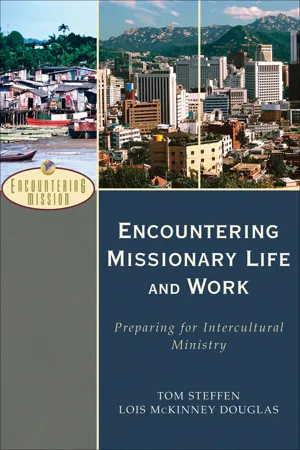![]()
![]()
1
Remembering the Past
Scripture and history are saturated with the fingerprints of our missionary God.
Alicia Britt Chole (2000, 59)
Remembering the past, both distant and near, provides explanation and instruction for the present and the future. Thus, in this chapter we briefly highlight some of the more recognized missions players, as well as those who have not received as much attention, noting some of their bright spots as well as their blemishes. Some were strategists; some were strategist-practitioners; some were practitioners. Some placed the task over human and spiritual relationships, some the work over family, and some their family over work. Some finished well, while others left behind destroyed families. Some suffered physically for Christ; some were martyred, while others only experienced verbal abuse. Even so, the hand of God is evident throughout the careers of these servants of God as they attempted to live and work as co-laborers with him in very different and often difficult places. What can twenty-first-century cross-cultural Christian workers learn from our predecessors about the total ministry package, that is, the walk and the work? How should their lives influence our lives?
Today’s cross-cultural Christian workers will do well to reflect on those who have walked, or are presently walking, the missional path. These individuals can help us to better understand the life and times of today’s missionaries. Given the numerous cross-cultural Christian workers since the first century, we must be selective. The chapter begins with Luke, moves from Constantine to Luther and Count Nikolaus Ludwig von Zinzendorf. From there we shift our focus to more contemporary figures: William Carey, Eleanor Macomber, J. Hudson Taylor, Charlotte (“Lottie”) Diggs Moon, Ralph D. Winter, Joanne Shetler, Luis Bush, Omar Gava, Natasha, and Martin and Gracia Burnham. Drawing from their lives, we identify some of the implications for twenty-first century missionaries in relation to Holy Spirit–directed living and practice.
LUKE
Luke, a well-traveled medical doctor, a good friend of Paul, an outstanding researcher, writer, missionary-theologian, and the only Gentile author in the New Testament, highlights the expansion of the Jesus movement (called “the Way”) in two volumes we know as Luke and Acts. Better thought of as a single unit, Luke-Acts features a selective collection of stories that comprise two-fifths of the New Testament, covering approximately seventy years. The stories found in Luke-Acts introduce a varied cast of human characters—Peter, John, Barnabas, Stephen, Philip, Cornelius, James, Paul, Lydia, Priscilla, Drusilla, Bernice. It also includes spiritual characters, God the Father, Jesus, the Holy Spirit—and the enemy of humanity known as Satan. Unquestionably the dominant spiritual character in Luke’s stories is the Holy Spirit.
The Holy Spirit provided the young followers of the Jesus movement the power to expand God’s kingdom (Acts 1:3, 5; 8:12; 14:22; 19:8; 20:25; 28:23, 31) in Jerusalem, Judea-Samaria, and to the far-flung corners of the then-known world (Acts 1:8). Through a combination of signs and wonders, oral communication of the gospel, suffering, and persecution, churches were born, multiplied, and matured throughout the Mediterranean. The gospel crossed ethnic boundaries, creating a universal church composed of Jews and Gentiles. Luke documents the expansion of God’s reign as the gospel penetrates the barriers of ethnicity, gender, generations, geography, nationality, politics, and broken relationships with the Creator.
The Holy Spirit also provided direction to his coworkers (Acts 10:10–20; 13:2; 16:1–40). Desiring to take the gospel to the East, the Holy Spirit kept the Pauline team “from preaching the word in the province of Asia” (16:6). At a later date the team concentrated on Ephesus (19:1–41), thereby strategically reaching all of Asia, including the seven churches referenced in Revelation. In the meantime, the Jesus movement marched west through the continents of Europe and northern Africa. How different the church history books would be today if the Holy Spirit had led the Pauline team east toward China rather than west.
SIDEBAR 1.1
WOMEN NOTED IN LUKE-ACTS
The following women are noted in Luke’s two accounts in the New Testament. As you look through the list, choose those you do not know very well and read their stories.
| LUKE | ACTS |
|
|
- Mary and Elizabeth (1:24–2:35)
- Anna (2:36–38)
- Herodias (3:19)
- Widow of Zarephath (4:26)
- Simon’s mother-in-law (4:38)
- Widow of Nain (7:11–12)
- Sinful woman (7:36–50)
- Mary Magdalene, Joanna, and Susanna (8:3)
- Jesus’s mother (8:19–20)
- Mary and Martha (10:38–42)
- Unnamed women (11:27–28)
- Queen of the South (11:31)
- Woman with spirit infirmity (13:10–17)
- Woman who lost coin (15:8–10)
- Lot’s wife (17:32)
- Widow (18:1–8)
- Poor widow (21:1–4)
- Maid (22:56–57)
- Women who mourned for Jesus (23:27)
- Women from Galilee (23:49, 55; 24:10)
| - Sapphira (5:1–11)
- Widows (6:1)
- Candace (8:27)
- Dorcas (9:36–41)
- Widows (9:39, 41)
- Mary, mother of John Mark (12:12)
- Rhoda (12:13)
- Lydia (16:13–15)
- Slave girl who predicted future (16:16–18)
- Leading women (17:4)
- High-standing Greek women (17:12)
- Damaris (17:34)
- Priscilla (18:2–3, 18, 26)
- Four unmarried daughters who prophesied (21:9)
- Drusilla (24:24)
- Bernice (25:13, 23; 26:30)
|
- How many of the stories of these women do you know?
- Given the number of women mentioned in Luke-Acts, why do we not hear more of them in missions history?
Acts ends abruptly, leaving the impression that the job of expanding God’s reign has yet to reach completion. Many questions remain unanswered. Why does Luke end his narrative with Paul in jail? Why does Luke make Paul’s arrival in Rome so anticlimactic? Was Paul eventually released? Did he ever reach Spain? Did Luke plan to write a third volume? What happened to Peter and James after Acts 15? What happened to Barnabas? Perhaps the message of Acts is much larger than the monumental roles played by Peter, James, Barnabas, and Paul in the Jesus movement. Luke’s message is more about the unstoppable power of the Holy Spirit and the Word of God to expand God’s kingdom globally than about the enemy’s ability to thwart key leaders within the Jesus movement.
Although the Jesus movement documented by Luke was not without significant theological and cultural differences and challenges (Acts 15), persecution, and martyrdom, it did gain a unified and legitimate identity. Although tied historically to Judaism, the new movement slowly became distinct from it, moving beyond Palestine. Through “word and deed” the people of “the Way” would eventually advance to Italy, Europe, North America, Latin America, Africa, and Asia. But we get ahead of ourselves.
CONSTANTINE TO MARTIN LUTHER
After years of sporadic persecution of the faithful followers of Christ, the fourth century saw the emperor Constantine take a public stand for Christianity. Persecution slowed, as did aggressive evangelism. State-sponsored religion driven by creeds, church buildings (in contrast to house churches), politics, and colonial imperialism slowly replaced vibrant followers of Christ with nominal Christians. Even so, over the coming centuries God continued to send dedicated workers to expand his kingdom, including Ulfilas to the Goths, Patrick to the Celts, Willibrord to the Vikings, Augustine to England, and Leif to Greenland. The dark days for Christendom would return again during the bigoted Crusades (1095–1600s), dividing the Eastern and Western church and increasing hatred between Muslims and Christians. But spiritual light would again burn brightly during the Reformation.
Luther, Calvin, Zwingli, and a spate of others challenged a decadent papacy. Through their courageous efforts, first-century understanding of justification by faith replaced the then-current misunderstandings of a works-oriented salvation. A revival began that would change the course of history. Even so, mission theology and practice received little if any attention. Kenneth Latourette provides five possible reasons for this: (1) the apostles had already fulfilled the Great Commission; (2) they were preoccupied with “home” work; (3) political authorities were responsible for public worship; (4) there was no general awareness of the non-European world; and (5) Luther believed the world was near the end (1939, 3:23).
Donald McGavran (1988, 3) expands on Latourette in explaining Protestant seminary training from 1550 to 1800. Sealed off by Muslim armies to the south and the east and Spanish and Portuguese navies to the west, the Reformers believed that their job was to Christianize the masses of Roman Catholics swept into the Reformation. He argues that this led to a “maintenance mentality” that was reflected in seminary curricula and church practice. Sadly, this orientation remains to this day. The Reformation focused on improving adherents’ understanding of Christianity within existing churches rather than planting and multiplying new ones. Maturation was more important than multiplication.
COUNT NIKOLAUS LUDWIG VON ZINZENDORF
German Count Nikolaus Ludwig von Zinzendorf (1700–1760) became the father of the Moravian missionary movement and, on a broader scale, laid the foundation for Protestant global missions. Growing up under the influence of Pietism—a movement during the late seventeenth and mid-eighteenth centuries that emphasized the blending of Bible doctrine, individual piety, and faithful practice—he practiced what his grandmother and aunt had modeled. When religious Protestant refugees from Moravia appeared unexpectedly, he offered them a place to stay on his land at Herrnhut, Germany. When they continued to come, his door remained open in spite of strong family opposition. On August 13, 1727, revival spread through the growing group of Moravians at Herrnhut, resulting in a great passion for missions. Through Zinzendorf’s vision and contacts and Christian David’s tireless efforts to bring refugee believers from throughout Europe to the count’s estate, the Moravians began a monumental movement that would take the good news of Jesus Christ to the unreached world. The first Moravian missionaries went to the Virgin Islands in 1732, sixty years before William Carey. Others followed God’s call to the West Indies, Asia, Africa, Russia, North America, and other places around the world. From the 1500s to the 1700s, the Moravians sent out more missionaries than all other Protestant groups combined.
The Moravians were the first Protestants to practice their duty as a church to evangelize “the heathen.” William Danker claims, “No church better illustrates the total apostolate” (Pierson 2000, 660). Forged out of persecution, this small group of refugees fled to Zinzendorf’s estate, where they began a community that integrated faith and economics. From this humble start would come “over half of the Protestant missionaries in the eighteenth century” (ibid.). Their purpose in going out was twofold: to reach the unreached and to renew faltering churches.
Comprised of called clergy and laypeople, male and female, married and single, and expected to work to support themselves, the Moravians set out for the far corners of the world, where they formed self-supporting communities. Their for-profit model helped the Moravians identify with the community, taught those they reached the dignity of labor, and provided funds for the support and expansion of missions. For-profit business found its basis in the Moravians’ philosophy that regarded “the...

